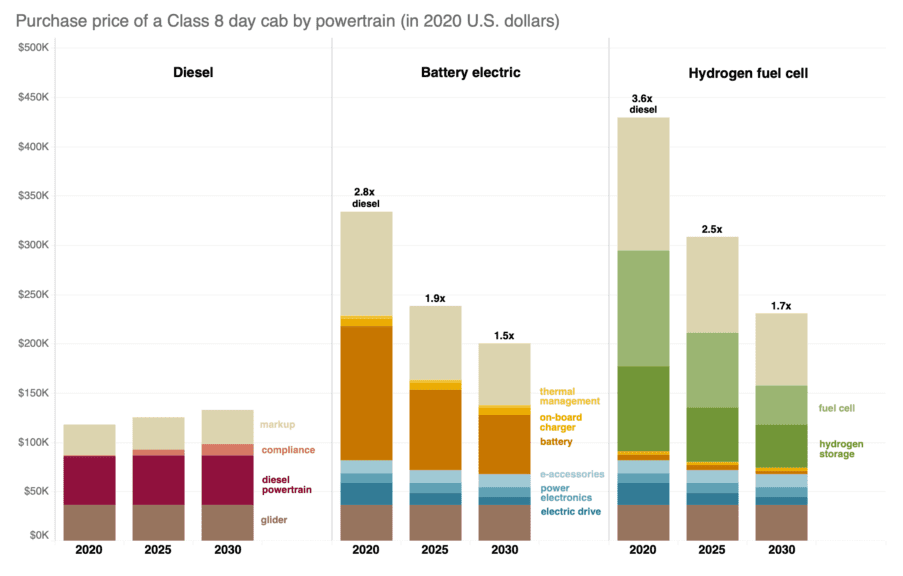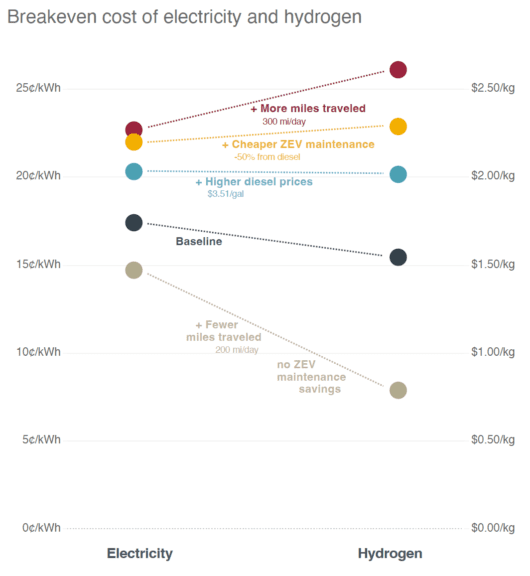Blog
How much does an electric semi really cost?
Information on real-world electric truck prices is notoriously difficult to come by. This is especially true for biggest and baddest of them all: the electric semi. While there have been several high-profile deliveries of electric semi-trucks in the past few years, their purchase price has largely been kept under wraps as the market scales up. The trouble is, the cost calculus for fleet owners hinges on exactly how much more it costs to buy an electric truck than a diesel truck—and how fuel and maintenance savings may make up the difference.
We can glean a few ballpark numbers from press releases. For example, the Port of Oakland recently acquired 10 Peterbilt 579EVs at a cost of $5.1 million. If this represents the true upfront purchase price—not including a maintenance contract, for example—it would translate to $510,000 per semi-truck. Another example: back in 2020, Lion Electric received a $20 million order for 50 8T electric trucks, working out to $400,000 per truck. Meanwhile, Tesla has been advertising a mind-bogglingly low price of $180,000 for their yet-to-be-delivered 500-mile electric semi.
There’s a lot of guesswork involved in determining real-world purchase prices, so rather than relying on public announcements, we made our own estimate from the bottom up. For major e-truck components, such as the battery, fuel cell stack, and electric motor, we used average cost estimates from our recent literature review. For the remaining costs, we used component-by-component cost estimates for diesel, battery electric, and hydrogen fuel cell trucks from an ICCT-commissioned analysis by Ricardo Strategic Consulting. We chose vehicle specs that are representative of models currently advertised in the North American market—a 350 kW electric motor, 70 kg hydrogen tank, and 180 kW fuel cell stack—as well as a 600 kWh battery to represent longer-range battery-electric models like the Freightliner eCascadia and Nikola Tre. We applied an overall 36% markup from direct manufacturing costs for all trucks, plus an additional 10% for zero-emission trucks to cover research and development, retooling, and overhead costs.
The figure below shows how much we estimated a zero-emission truck would cost:

Purchase price of a Class 8 day cab by powertrain (in 2020 U.S. dollars)
Based on these numbers, we’d expect a 2022 battery electric truck to cost two to three times it’s diesel counterpart before incentives; and make that three to four times for a fuel cell truck. Luckily, there are purchase incentives: California’s HVIP program offers $120,000 vouchers for the purchase of zero-emission tractor trucks and Washington state offers a commercial vehicle tax credit covering up to $100,000 of the incremental cost for new alternative fuel vehicles. With incentives like these, a battery electric truck in 2025 could cost nearly the same price as a diesel truck. A fuel cell truck could cost only 50%–70% more.
But wait, there’s more. The total ownership cost of a truck is a combination of its upfront costs, namely the cost of the truck, and ongoing operational costs like fuel and maintenance. It’s these operational costs where zero-emission trucks can really shine. So, just how much must zero-emission trucks save in fuel and maintenance to outcompete diesel overall?
Let’s consider a driver performing local haul operations, logging 250 miles a day or roughly 62,500 miles annually. We’ll assume the driver’s truck will be purchased new in 2025 and kept in service for 5 years, and we’ll ignore any difference in resale value between a five-year-old zero-emission truck and a diesel. We can expect diesel trucks to get 7 miles to the gallon based on current U.S. regulations, with maintenance costs of approximately 15¢ per mile. For starters, let’s use a pre-pandemic diesel price of $3.06 per gallon.
Here’s what we calculated:

Local haul truck in 2025 with pre-pandemic diesel prices, 5-year ownership
Based on this quick calculation, the fuel and maintenance costs of battery electric trucks must be just 15% lower to break-even with diesel. For hydrogen fuel cell trucks, fuel and maintenance must come in 45% lower than the cost of diesel.
What about infrastructure, you ask? For simplicity, this calculation assumes it’s bundled into the cost of fuel, as it would be for public charging and fueling stations. And in fact, we can estimate how much these public stations would need to charge to tip the scales towards zero-emission.
Applying the energy consumption (e.g., kWh/mi) simulated in a recent ICCT study to the baseline scenario above, and assuming a 25% reduction in maintenance costs for zero-emission trucks, the break-even cost of charging would be 17¢ a kilowatt-hour. For hydrogen, the break-even cost would be $1.55 per kilogram.
This break-even cost will change if we tweak a few of our assumptions. For example, if diesel prices don’t return to pre-pandemic levels and instead remain high, as they were in the second half of 2021, it makes it even easier for zero-emission trucks to compete. Fuel and maintenance overall must only come down by 14% (battery electric) or 41% (hydrogen fuel cell), which translates to a fuel cost of 20¢ per kilowatt-hour for electricity and around $2 per kilogram for hydrogen.
Here’s the breakeven cost when we make a few more of these tweaks:

Breakeven cost of electricity and hydrogen
While break-even hydrogen prices are still pretty far from reality—prices in California were upwards of $15/kg in 2019—the electricity prices aren’t. On average, U.S. electricity rates in 2020 were roughly 13¢/kWh for residential customers and 11¢/kWh for commercial customers. In Seattle, which has some of the nation’s cheapest and cleanest electricity, a commercial charging rate pilot program offers less than 6¢/kWh during off-peak hours with no demand charges. Even if this rate were tripled to cover the cost of charging infrastructure, battery-electric trucks would still win out over diesel. And the city’s public DC fast-charging stations currently charge just about that, coming in just under 20¢/kWh.
This is a quick and dirty cost analysis, and we’ve published much more comprehensive ones for China and Europe, with a North America-focused analysis slated for this year. But the simple math we’ve done here makes it clear that the economics of owning a battery electric semi are right up there with diesel. And that’s a pretty clean answer—in fact, it’s zero-emission.
